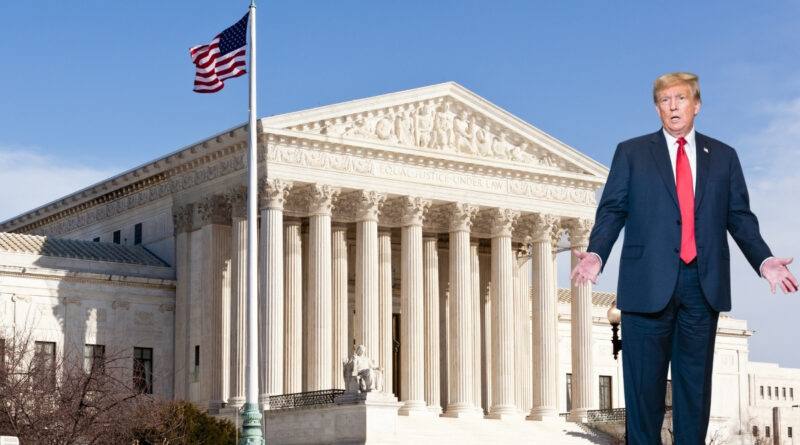Supreme Court To Be Now Deciding On Trump’s Tariffs
Economy & Business | The WFY Magazine, September 2025
Supreme Court to Decide on Trump’s Tariffs: Billions at Stake
The United States Supreme Court has taken the unusual step of fast-tracking a case that will decide whether President Donald Trump acted lawfully in imposing sweeping new tariffs on imports. At issue are duties that affect trillions of dollars in trade flows, including goods exported from India, and that have already disrupted supply chains across multiple sectors.
For businesses, the stakes are enormous. A ruling in favour of the President could cement a powerful executive tool in trade negotiations, locking in higher costs for importers and consumers. A ruling against him could force the U.S. government to refund tens of billions of dollars already collected, halve average U.S. tariff rates, and unsettle ongoing trade deals. Either way, Indian exporters, small diaspora-run firms in America, and global trading partners face a period of heightened uncertainty.
Perfect — let’s tighten the framing so it fully fits the Economy & Business section. You don’t need to rewrite the full piece, but you do need to adjust the sub-headings to make them sound like a business/economic analysis.
Business Impact of the 2025 Tariffs
On 2 April, the administration announced what it called a new approach to trade barriers, pairing a universal baseline tariff with country-by-country “reciprocal” rates that extend much higher. Subsequent executive orders adjusted the schedule and timing. The legal hook cited for the programme is the International Emergency Economic Powers Act of 1977, a law usually used for targeted sanctions, asset freezes and similar measures tied to declared emergencies. (The White House)
The headline numbers matter. Analysts and research groups tracking collections report that the effective average U.S. tariff jumped well above pre-2025 levels. One widely cited set of estimates suggests the effective rate moved into double digits soon after the April action, with later adjustments pushing the figure higher. Other trackers put the statutory rate even higher than the effective rate because of exemptions and timing. The broad direction is clear: a sharp rise compared with roughly 2 to 3 per cent in recent years. (The Budget Lab at Yale)
For India, the shift has been especially visible. Independent assessments indicate the effective U.S. tariff on Indian goods has leapt from low single digits last year to above 20 per cent at points this summer, with higher country-specific rates applied to sensitive product lines. Indian jewellery and several textile categories have faced the highest bands, although pharmaceuticals and smartphones have seen carve-outs. (The Economic Times)
Diplomacy has scrambled to keep pace. Washington and New Delhi have reopened trade talks, and senior officials on both sides have signalled interest in a phased de-escalation if parallel issues move forward. This is a fluid picture, but the legal timeline now threatens to overtake the diplomatic one. (Politico)
The Legal Battle Driving Market Uncertainty
Two sets of challengers have pushed the courts to stop the tariffs. One group is made up of small importers and a coalition of states. Another involves two family-owned educational-toy companies. A federal trade court ruled for the challengers in May. At the end of August, an eleven-judge appeals court largely agreed, holding by seven votes to four that the emergency-powers statute does not authorise the President to impose broad, indefinite tariff schedules on most imports. The government appealed immediately. (Federal Circuit Court)
On 9 September, the Supreme Court accepted the cases, consolidated them, and set an aggressive briefing calendar: opening briefs by 19 September, responses by 20 October, reply by 30 October, with arguments in the first week of November. That speed underlines the scale of the economic stakes. (Supreme Court)
At the centre of the legal dispute lies a straightforward question. Does a law that lets presidents “regulate” imports during national emergencies also let them create the equivalent of a new tariff code, across most trading partners, for as long as they deem necessary. The appeals court’s majority said no. In their view, Congress writes tax and tariff rules unless it clearly says otherwise, and the emergency law does not speak plainly enough to hand over such a large fiscal lever. The Supreme Court will now say whether it agrees. (Federal Circuit Court)
The justices are likely to consider familiar constitutional ideas. One strand is the separation of powers, where tax and tariff authority sits with Congress unless Congress has explicitly delegated it. Another is the modern “major questions” doctrine, which asks courts to demand clear words from Congress before letting the executive take steps with vast economic or political significance. Congressional researchers have already flagged how these doctrines might apply to the emergency-tariff claims. (Congress.gov)
Billions in Revenue, Refunds, and Consumer Costs
This is not a technical dispute over minor fees. It is a decision that could shuffle trillions of dollars over time and move prices for households and firms.
- Potential revenue haul: Non-partisan estimates suggest that a near-universal tariff uplift could raise several trillion dollars over a decade if fully implemented and sustained, although the net figure would be lower after economic feedbacks. One prominent briefing put the gross figure near 3.9 trillion U.S. dollars over 2025 to 2034 under a scenario of a 15-point uplift. (PIIE)
- Near-term collections: Academic trackers estimate 2025 tariff collections running in the tens of billions already, with monthly figures rising as more lines take effect. These researchers also distinguish between statutory rates and effective rates actually collected at the border. (The Budget Lab at Yale)
- Who pays: A wide economics literature finds that a significant share of tariff costs falls on domestic firms and consumers. Reporting around the Supreme Court case highlights estimates that roughly half or more of the burden is borne within the United States, through higher input costs and retail prices. (Wall Street Journal)
- Refund risk: If the Court strikes the tariffs down, the government may have to refund a large share of what it has collected. These ranges vary widely because they turn on timing and scope, but even conservative scenarios run into the tens of billions. Some coverage points to much larger exposures if every affected import line is included. (Reuters)
- Effective rate shock: Live updates from financial newswires have tracked the rise in the effective tariff rate from around 2.4 per cent pre-April to figures several times higher after April’s action and later steps. The message for business planning is simple. Crossing the U.S. border has become far more expensive in 2025 than it was in 2024. (Yahoo Finance)
What Tariffs Mean for Indian Exporters and Diaspora Firms
The United States is India’s top export market by a clear margin. In merchandise alone, nearly 18 per cent of India’s exports in 2023-24 were destined for the U.S., and the share edged higher in 2024-25. Services exports to the U.S. are also strong and still growing, but the present dispute is about goods, not services. When tariff rates on Indian goods jump, the effect ripples through Surat’s diamond units, Tiruppur’s knitwear exporters, Noida’s electronics parks, and the vast constellation of small suppliers behind them. (The Indian Express)
Sector detail helps. Diamonds and jewellery rely heavily on U.S. buyers, and this category has already felt the chill from higher rates and buyer caution. Several apparel lines face higher tariffs in specific bands. Auto-component exporters report mixed treatment, with some parts exposed to high rates while others sit under different regimes. Pharmaceutical products and some electronics have received exemptions. The net effect is still a significant increase in the average duty faced by Indian goods at the U.S. border this year. (Reuters)
For diaspora families, the consequences arrive in quiet ways. Import-heavy retailers pass on costs. Restaurants that rely on specific spices, oils or packaged foods juggle menus. Small e-commerce sellers who import inventory from India to U.S. fulfilment centres see their margin plans torn up. These are not headline stories, but they are daily realities across our community.
There is a macro story too. India’s combined goods and services exports crossed 820 billion U.S. dollars in 2024-25 according to official data. That top-line strength reflects diversification and resilience, but the composition matters. A sustained tariff shock in the U.S., our largest market, can still dent growth, shift production lines, or accelerate efforts to reroute trade through third countries, which carries compliance risks of its own. (Press Information Bureau)
Trade Diplomacy and Global Market Repercussions
Trade talks between Washington and New Delhi are back on, with ministers and envoys signalling interest in partial settlements and phased relief. From India’s side, officials have described “active dialogue” on a deal, while American reporting has kept an eye on how the tariff court fight interacts with those negotiations. Setbacks or breakthroughs can come quickly in this setting, but any agreement will now sit in the shadow of the Supreme Court calendar. A judgment in November or December could force a reset in both capitals. (Politico)
The wider geopolitical context complicates everything. The administration in Washington has linked parts of its tariff posture to concerns about drug trafficking, supply chains and leverage in foreign policy. Separate statements have urged allied governments, including in Europe, to take a tougher tariff line toward China and India for reasons tied to the war in Ukraine. These cross-currents raise the stakes for India, which is balancing strategic partnerships with economic interests. (The Guardian)
Possible Outcomes and Market Scenarios
Scenario 1: The Court upholds the tariffs
If a majority accepts a broad reading of emergency powers under the statute, the presidency gains a potent fiscal instrument that future administrations could use for trade leverage or other goals. Commentators have already warned that such a reading would shift a tax-like power from Congress to the executive. Markets would assume tariffs are a semi-permanent feature unless Congress acts, and revenue projections in the trillions would remain in play, even if later negotiated down. (Wall Street Journal)
Scenario 2: The Court rejects the tariffs
If the Court agrees with the lower courts, the government will have to roll back the affected tariff schedules and prepare to return at least a portion of the money collected. Importers will recalculate orders, and trading partners will press for clarity on future rules. Congress could still legislate new authorities, but that would require a political bargain. The executive would lose a major piece of negotiating leverage, and the legal boundary around emergency powers would be clearer. (Reuters)
Scenario 3: A mixed ruling
The Court may draw a line between narrow, time-limited emergency actions and broad, open-ended tariff codes. It might allow some parts of the programme and reject others, or it might send the case back for a remedy that avoids an immediate universal unwind. For businesses, this is the most complex path, because the exact contours would matter more than the headline.
Action Points for Exporters, Importers, and Businesses
While lawyers argue in Washington, firms can still act.
- Map exposure by HS line. List the top ten tariff lines that matter to your shipments, including any exclusions that apply. Track statutory and effective rates separately. Many small firms do not realise how country-specific reciprocal rates interact with the baseline. (The White House)
- Budget for two prices. Build scenarios for both a status-quo tariff and a rollback after a Court decision. Adjust retail prices or wholesale quotes accordingly.
- Review routing and rules of origin. Do not assume that re-routing via a third country is a cure-all. U.S. customs applies rules of origin tests and penalties for evasion. Several major banks and research houses have flagged large attempts at tariff avoidance, which increases compliance scrutiny. (Barron’s)
- Watch the calendar. The Supreme Court has set clear dates for briefs and arguments. Expect volatility in markets and in shipping decisions around those milestones. (Supreme Court)
- Use temporary mechanisms if cash is tight. Some importers manage cash flow by adjusting invoice terms or seeking duty-drawback or bonded-warehouse options where they qualify. Speak to a qualified trade adviser before acting.
- Engage customers early. If you sell into U.S. retail chains, notify buyers about potential price changes under each scenario. Early communication beats last-minute renegotiation.
Key Statistics Shaping the Tariff Debate
A few additional figures help frame the debate for readers who prefer data to slogans.
- Effective rate spike: Financial trackers put the post-April effective U.S. tariff rate above 10 per cent for several months, with some estimates suggesting even higher figures once later measures are included. Pre-2025 levels were around 2 to 3 per cent. (The Budget Lab at Yale)
- Share of federal revenue: Even with the surge, tariffs remain a modest share of total federal receipts this year, on the order of a few per cent. That average hides sharp sectoral stress because costs are concentrated in tradable goods. (PIIE)
- India’s exposure: India shipped roughly one-fifth of its merchandise exports to the U.S. in 2023-24. The United States remains India’s largest single merchandise market. Services exports to the U.S. continue to grow, although they sit outside the present tariff fight. (The Indian Express)
- Sector pinch points: Gems and jewellery rely heavily on the U.S. consumer. Several apparel lines and some auto-components have faced high tariff bands. Pharmaceuticals and smartphones have seen partial exclusions. Outcomes differ line by line. (Reuters)
- Briefing and argument dates: Opening briefs by 19 September, responses by 20 October, reply by 30 October. Arguments in the first week of November 2025. (Supreme Court)
Relevance for the Global Indian Business Community
This is not just a courtroom drama. It is a kitchen-table story for many Indian families abroad. The trade link with the United States is more than a statistic. It is a network of shop floors in Coimbatore, diamond polishers in Surat, fabric printers in Erode, and sales teams in Edison, New Jersey. It is the rhythm of invoices, shipping schedules and payrolls. When policies raise or lower the bridge between these worlds, families feel it in their budgets and in their plans.
There is also a civics lesson here. Democracies allocate big powers carefully. When courts ask whether emergency laws permit the executive to set far-reaching tariffs, they are testing the boundary between speed and consent. However the justices decide, the ruling will tell us something about how the United States balances urgency with process.
Timeline and Signals for Markets to Track
- Oral arguments in early November. Listen for questions about the text of the statute, the scale of the economic impact, and whether Congress spoke clearly enough to hand over tariff power in emergencies. (SCOTUSblog)
- Market moves as each brief lands. Even a single filing can shift expectations on refunds or on how much of the programme might survive. (Supreme Court)
- Trade talks between India and the United States. A narrow legal ruling can still leave room for negotiated relief on particular sectors. (The Times of India)
- Sector-specific guidance from customs and regulators. Exemptions, phased entries, and compliance advisories will matter as much as headlines.
For our community, this is a time to move from worry to planning. The legal path is short now. The economic choices are clearer than the noise suggests. Map your exposure, prepare a Plan A and a Plan B, and keep a close eye on the Court’s calendar. Whatever the justices decide, Indian businesses and diaspora households can stay steady if they act early and stay informed.
© The WFY Magazine | The WFY Bureau Desk |
Key sources for facts and figures
- Supreme Court fast-track review, November arguments, and briefing deadlines. (SCOTUSblog)
- Federal Circuit en banc opinion holding IEEPA does not authorise the tariff programme. (Federal Circuit Court)
- Background on the executive orders and “reciprocal” tariff framework. (The White House)
- Effective tariff rates and collections after April 2025. (The Budget Lab at Yale)
- Revenue projections and incidence of tariff costs. (PIIE)
- India–U.S. trade context and sector exposure. (The Indian Express)
- India–U.S. talks resuming. (Politico)
Disclaimer: This feature is an original narrative prepared for The WFY Magazine using publicly available information as of 11 September 2025. It avoids reproducing third-party quotations. Statistics and facts are drawn from official documents and reputable outlets cited above. It is intended for general information and community interest, not for legal or financial advice.




